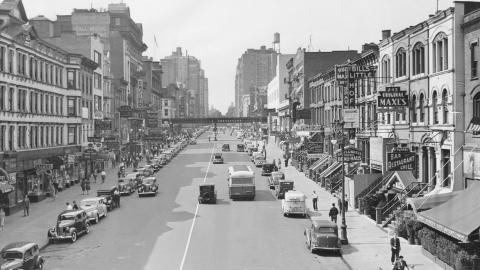It was in January in 1804 that a shocking slave uprising led to the creation of a new nation: Haiti. It was an audacious, epic conflict that would span many years, and see the rise of a man some have dubbed the black George Washington and the black Spartacus. So how did it happen, and what became of Haiti’s founding fathers?
A nightmare in the Caribbean
Before Haiti was Haiti, it was Saint-Domingue, a French colony on the Caribbean island of Hispaniola. French pirates began settling on the western part of the island in the 17th Century, with France eventually establishing formal ownership of the region, while Spain retained control of the rest of Hispaniola.
What it lacked in size, Saint-Domingue soon made up for in sheer economic might. This sun-soaked slice of a Caribbean island became one of the wealthiest colonies on the planet, thanks to the extravagant quantities of sugar and coffee it was exporting. In fact, at one point in the 18th Century, Saint-Domingue was supplying well over half of the world’s coffee supply. Good news for France, but very bad news for the countless slaves who were brought in from Africa to grow the precious crops.
Even by the standards of the Atlantic slave trade, the regime in Saint-Domingue was brutal and ruthless. The ravages of smallpox and yellow fever meant many slaves died within a few years of arrival, which meant the coldly pragmatic plantation owners decided it made sense to simply work them to death. Punishments were severe, food was inadequate, and slaves were even made to wear muzzles to stop them eating any of the sugar cane they toiled to cultivate day and night.
Viva la revolution
Things began to change in 1789, with the coming of the French Revolution. Suddenly, people back in France were fighting for Republican values, for equality and freedom. These ideas were enshrined in the Declaration of the Rights of Man, unveiled in France that same year. While slavery was not abolished, there was a new sense of possibility in the air.
At the time, the white plantation owners in Saint-Domingue were vastly outnumbered by their legions of slaves. As one French writer of the time put it, the wealthy planters 'slept at the foot of Vesuvius'. And the explosion finally came in August 1791, when the slaves finally rebelled against their hated masters in a lethally well-orchestrated uprising.
Bands of slaves went from house to house, killing the whites and setting plantations on fire. Years of pent-up suffering had been unleashed in an inferno of vengeance, with thousands killed and whole swathes of the island utterly destroyed. But this was not the end of the revolution. Far from it. The complex politics of the time meant that the colony would be locked in a messy and bloody struggle for many years to come.
The rise of the black George Washington
Whites on the island fought back against the insurgent slaves. As one indignant colonist wrote, 'There can be no agriculture in Saint Domingue without slavery; we did not go to fetch half a million savage slaves off the coast of Africa to bring them to the colony as French citizens.'
Yet the radical ideals of the French Revolution, along with a gnawing awareness that France needed the rebel slaves back on her side to keep Saint-Domingue from falling into Spanish or British hands, meant that an accommodation had to be reached. Amid the turmoil rose a charismatic leader, Toussaint Louverture. 'I was born a slave, but nature gave me the soul of a free man,' he once said, and his story was a miraculous one. Raised on a plantation, he developed a love of reading and learning, achieved his freedom in his early 30s and actually became a plantation owner himself, with his own slaves.
While he didn’t play a part in the earliest stages of the rebellion, his Machiavellian cunning and iron will lead him to rise up as the most persuasive figurehead of the movement. It’s telling that he used the language of the French Revolution to rally his men, declaring 'I want Liberty and Equality to reign in Saint-Domingue.' Yet his appeal to the heroic principles of the new France would not save him from a dark fate.
The birth of Haiti
France abolished slavery in 1794, a fact which many French people celebrated as proof of their moral superiority over the British. Yet the struggle in Saint-Domingue continued, with Louverture eliminating rivals to eventually establish himself as a virtual dictator in 1801. Some saw him as a hero, working to establish the colony as a place where Africans could work in peace and freedom. Others regarded him as a power-hungry despot-in-waiting. But time for Louverture was growing short.
By this time, Napoleon had taken power in France, and he was in no mood to nurture this brave new pseudo-state in the Caribbean. He dispatched an army, with the secret aim of overturning the new Saint-Domingue regime and re-establishing slavery. Louverture was arrested and brought back to France like a common criminal, where he would die in prison.
His lieutenant, a former slave called Jean-Jacques Dessalines, was the man who would finish the revolution by seeing off Napoleon’s forces and formally establishing a new, independent nation – Haiti – in January 1804. The bloodshed would not end there, as the vengeful and suspicious Dessalines ordered the wholesale slaughter of whites who remained in the new nation. Thousands of men, women and children would die in the Haiti massacre of 1804, and Dessalines himself would be assassinated a few years later. It was an ugly, violent epilogue to an achievement unparalleled in human history: the creation of a new country by those once who were once enslaved there.
For more articles about Black History, check out Sky HISTORY's Black History Month hub.
















